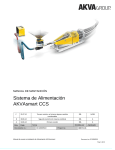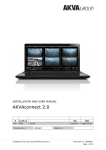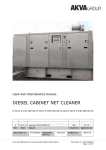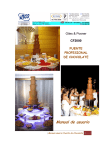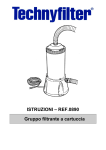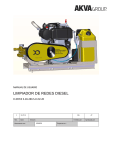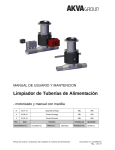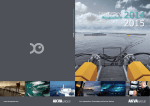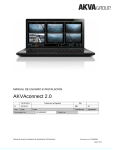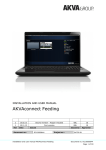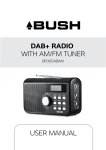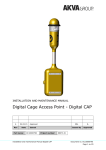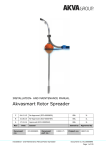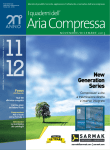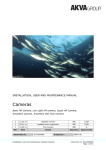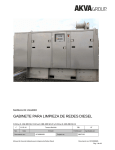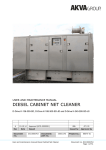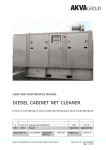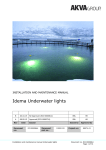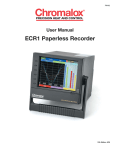Download UK Akvasmart CCS Feeding System Maintenance
Transcript
MAINTENANCE MANUAL Akvasmart CCS Feeding System B 25.09.14 Rev Date Document no.: Approved (ECO-0000588) Issued DC10000635 Documents part no.: Maintenance manual Akvasmart CCS Feeding system 10001158 EBL IL/HM Issued by Approved by Project no.: 88072-01 Document no. DC10000635 Page 1 of 44 For a thorough introduction of Your AKVA product, we ask that all users read this entire manual. If questions occur, contact us! The information in this document is subject to change without notice and should not be construed as a commitment by AKVA group ASA. AKVA group ASA assumes no responsibility for any errors that may appear in this document. In no event shall AKVA group ASA be liable for incidental or consequential damages arising from use of this document or of the software and hardware described in this document. We reserve all rights in this document and in the information contained therein. Reproduction, use or disclosure to third parties without express authority is strictly forbidden. Additional copies of this document may be obtained from AKVA group ASA at its current charge. © 2014 AKVA group ASA (NO) Maintenance manual Akvasmart CCS Feeding system Document no. DC10000635 Page 2 of 44 Table of contents 1 Safety .......................................................................................................5 1.1 Safety symbols ............................................................................................5 1.2 General ......................................................................................................6 1.3 Emergency-stop ..........................................................................................7 1.4 Safety risk related to the feeding process .......................................................7 1.5 Risks during installation, use, maintenance and repair ......................................8 1.6 Risk associated with live electric parts ............................................................9 1.7 Risks associated with high surface temperature ...............................................9 2 Introduction.............................................................................................10 2.1 Contact information .................................................................................... 12 3 Information .............................................................................................13 4 Blowers ...................................................................................................16 4.1 Check and change air filter Robuschi blower .................................................. 16 4.2 Check and change air filter Kaeser blower ..................................................... 16 5 Dosers .....................................................................................................17 5.1 Gasket and rotor cleaning ........................................................................... 18 6 Selector ...................................................................................................27 6.1 Internal selector cleaning ........................................................................... 27 7 Feeding pipes ..........................................................................................28 7.1 Prevention instructions ................................................................................ 29 8 Rotor spreader ........................................................................................30 8.1 Bearing cleaning ........................................................................................ 30 9 Main cabinet ............................................................................................31 9.1 Air filter .................................................................................................... 31 Maintenance manual Akvasmart CCS Feeding system Document no. DC10000635 Page 3 of 44 10 Emergency stop ......................................................................................32 11 Cooler .....................................................................................................33 12 Maintenance intervals .............................................................................34 12.1 Expected equipment life time ....................................................................... 35 12.2 Check lists................................................................................................. 36 12.3 Daily maintenance ...................................................................................... 37 12.4 Weekly maintenance - first half year ............................................................. 38 12.5 Weekly maintenance - second half year ......................................................... 39 Appendix A - Index ...........................................................................................40 Appendix B - Deviation form .............................................................................42 Appendix C - Notes ...........................................................................................43 Maintenance manual Akvasmart CCS Feeding system Document no. DC10000635 Page 4 of 44 1 Safety Safety for the users of our equipment is top focus when AKVA group ASA develop new products and product manuals. We therefore strongly recommend that everyone that use the equipment, all that perform any type of repairs, service or other maintenance to the product, and all that work in areas where the product is installed read this entire manual and at least this safety chapter. This recommendation is based on both personnel safety as well as a desire to keep the products in order and avoid damages risked if the safety instructions are not followed. 1.1 Safety symbols These safety symbols are used in this manual: Information Very important information Show caution, danger of minor personnel injuries and damages to equipment Warning - may cause personnel injuries Danger! - Will cause dangerous situations and danger for personnel Danger of high voltage 1.1.1 Other symbols used in this manual Go to or see page or chapter for further instructions or more information Maintenance manual Akvasmart CCS Feeding system Document no. DC10000635 Page 5 of 44 1.2 General The system must not be operated, and no work may be performed on the system before the safety precautions described in this manual have been read and understood. This safety information covers functions that are involved in the Akvasmart CCS feeding system maintenance. The information does not cover how to design, install and operate a complete system, nor does it cover all peripheral equipment, which can influence the safety of the total system. To protect personnel, the complete system has to be designed and installed in accordance with the safety requirements set forth in the standards and regulations of the country in which the system is installed. The system users are responsible for following these regulations, this is not AKVA group ASA’s responsibility. The Akvasmart CCS feeding system users have to ensure that the applicable safety laws and regulations in the current country are complied, and that the safety devices necessary to protect people working with the system, have been designed and installed correctly. People who work with the Akvasmart CCS feeding systems must be familiar with the operation and handling of the system, described in applicable documents. Apart from the built-in safety functions, the system is supplied with an interface for external safety device connections. Via this interface, external emergency stop switches can be incorporated into the system. Please refer to the emergency stop switches’ own installation manual for information on how to install this. Safety procedures must be followed to prevent personnel and equipment injuries Maintenance manual Akvasmart CCS Feeding system Document no. DC10000635 Page 6 of 44 1.3 Emergency-stop “A condition which overrides all other system controls, removes drive power from the motors, stops all moving parts and removes power from other dangerous functions controlled by the system.” The emergency stop must be activated when any danger to people or equipment occurs. A built in emergency stop button is located at the front of the main control cabinet door. Additional emergency stop buttons can be connected to the safety chain by the user, as long as they fulfill the requirements of “EN 418 Safety of Machinery, Emergency stop equipment, functional aspects.” Before restarting anything after an emergency stop, the reason of the stop needs to be examined and repaired 1.4 Safety risk related to the feeding process The system automatically starts feeding in accordance with an user defined schedule. This schedule may be predetermined, or it follows signals from for instance the Doppler pellet sensors. Feed is transported from the silos to the cages using compressed air, and the fish feed have a high speed when leaving the transport pipe via the rotor spreader. Personnel must not be in the area around the pipe outlet, unless the system main switch has been turned off and secured in locked position, because of the risk of injury related to flying feed pellets. Covers on blowers, dosers and selectors must never be removed during operating mode/feeding. The farm owner and the operations manager are responsible for installing appropriate warning signs regarding this risk prior to setting the system into operation. Maintenance manual Akvasmart CCS Feeding system Document no. DC10000635 Page 7 of 44 1.5 Risks during installation, use, maintenance and repair To prevent injuries and damages during installation, use, maintenance and repairs, the regulations applicable in the country concerned, and the instructions from AKVA group ASA (hereunder this manual), must be complied with. Special attention must be paid to the following points: - Electric shock may appear because of the static electricity appearing between the pellets and the HDPE pipe material. The electricity inside may cause severe shocks when cutting the pipes endangering the life and health of the user. Cutting should only be performed by qualified personnel - The instructions in product specification manual, installation-, maintenance- and repair manuals must always be followed - The system supplier must ensure that all circuits delivered with the safety functions are interlocked in accordance with the applicable standards for that function - Those who install the system must have the appropriate training for the system in question, as well as for any safety matters associated with it - Emergency stop buttons must be positioned in easily accessible places so that the system can be stopped quickly - Those in charge of operations must make sure that safety instructions are available for the installation in question. Although troubleshooting may, on occasion, have to be carried out while the power supply is turned on, the main rule is that the system must be turned off and secured in OFF position during installation, maintenance and repairs, thus disconnecting all electric leads and disconnecting or connection of units. Maintenance manual Akvasmart CCS Feeding system Document no. DC10000635 Page 8 of 44 1.6 Risk associated with live electric parts A danger of high voltage is associated with the following parts of the system: - The mains supply/mains switch of the main control cabinet - The frequency inverters of the main control cabinet and the selector valve - The motors for driving the dosers and the selector valves - The external voltage connected to the control cabinet mains switch remains live even when the mains switch itself is turned off. 1.7 Risks associated with high surface temperature The outlet air of the blower can be hot when the system is running. This means that the air transport pipes are very hot, and these surfaces must not be touched without using protective gloves, because touching presents a risk for personnel injury. Care must therefore be taken to avoid touching these pipes without protective gloves before they have cooled down. It is the responsibility of the farm owner and the operations manager to install proper warning signs regarding the hot surfaces, these signs must be put up prior to any operation of the system. The dosers’ motor and the selector valve motor can become hot during system operation. This presents a risk for personnel injury, and care must be taken to avoid touching these components without protective gloves before they have cooled down. INFORMATION IN THIS SAFETY CHAPTER MUST NOT BE REGARDED AS A WARRANTY FROM AKVA GROUP ASA. THE FEEDING SYSTEM MAY CAUSE DAMAGE EVEN IF THE SAFETY PROSEDURES ARE FOLLOWED Maintenance manual Akvasmart CCS Feeding system Document no. DC10000635 Page 9 of 44 2 Introduction This user manual is part of the equipment delivered with Akvasmart CCS Feeding System. Preserve this manual for as long as the equipment is being used, and make sure that all changes done to the system and its equipment are being noted in the back this manual. Thank you for choosing AKVA group ASA as supplier for your feeding system. Do not hesitate contacting us if you need more information regarding use or maintenance for your product. With four house brands, AKVA group ASA is a world leading supplier of technical aquaculture equipment. Since 1980 we have developed and produced fish farming equipment, both for cages at sea and for land based hatcheries. AKVA represents an industrial standard, which is presumed to be the turn key to the future. Research, project management, fast deliveries and customer follow-up have been in focus to ensure that we deliver the best possible and most cost efficient equipment, and thus contributing to preserve a sustainable aquaculture and a positive development within the aquaculture industry. We have a wide variety of products, for example: plastic and steel cages, high pressure washers, net washers, boats, feed barges, feeding systems, cameras, sensor systems, under water lighting, software for fish farming and recycling systems. We practice continuous product development to improve the equipment’s safety, functions, manner of operation and working reliability. This manual enables the operator to install and maintain Akvasmart CCS Feeding system in a safe and economically way. Maintenance manual Akvasmart CCS Feeding system Document no. DC10000635 Page 10 of 44 All of our feeding system products are developed according to these European directives: • EMC directive, 2004/108/EC • Low voltage directive, 2006/95/EC • Machinery directive, 2006/42/EC All of our equipment is pre-installed, tested and delivered from our own production department or from approved collaborators. This means that our customers have total control of components to choose from, grouping collocation, testing and deliveries. Our production staff consists of people with great expertise and enthusiasm to produce the best possible products for you. Having our own production site gives you excellent service in case something should go wrong, or if you are in need of any assistance. We hold most of the parts for your equipment in stock, and our service staff is available on the telephone or on location in order to assist you if necessary. This entire manual, and especially the safety chapter must be read and understood before commencing any work on the components of the Akvasmart CCS Feeding system This manual must be read and understood, and maintenance must be performed as described here to ensure reliable operations. Maintenance manual Akvasmart CCS Feeding system Document no. DC10000635 Page 11 of 44 2.1 Contact information AKVA group ASA - Bryne (Head Office) Nordlysveien 4 PO. Box 271 N-4340 Bryne, Norway tel. +47 - 51 77 85 00 fax. +47 - 51 77 85 01 Support Hardware and AKVAconnect tel. + 47 - 51 77 85 03 [email protected] Support Fishtalk tel. +47 - 73 84 28 20 [email protected] Maintenance manual Akvasmart CCS Feeding system Document no. DC10000635 Page 12 of 44 3 Information The central feed system concept was invented by AKVA in 1980 and Akvasmart CCS Feed System is today the most popular and reliable feed system worldwide. The system is suitable for all species feeding on pellets. It is now also fully integrated with camera control, pellet- and environmental sensors, as well as Fishtalk production control software. All feeding and environmental data is stored in the Fishtalk database. This unique integration allows for full overview and control of all operational activities from farm site to top management level. The Akvasmart CCS Feed System will feed the correct amount, at the optimal rate, on time and every time. This powerful system provides great opportunities to optimize the entire feeding process. AkvaControl is the leading edge feed system software, now part of the Fishtalk software family. New functionality includes meal planner, group feeding and adaptive feeding. Combined with data from environmental sensors, this allows for efficient analysis and benchmarking between farm sites. The Akvasmart CCS Feed System is designed to handle more than 40 feed lines running i parallel and more than 1000 cage/ tank units, centralized- or hopper feeders, all operated from one PC, iPad or smartpone. Akvasmart CCS is the perfect choice for feeding fish, designed to fit the requirements from low capacity system such as CCS-32, up to high capacity systems such as CCS-110. The Akvasmart CCS Feed System is designed to fulfill all feeding requirements, regardless of species or how you want to feed your fish. Maintenance manual Akvasmart CCS Feeding system Document no. DC10000635 Page 13 of 44 The configuration of the system is based on the following factors: - Transport lengths - Biomass - Number of units (cages) - Species A custom doser is used to transfer the feed into the air flow. The doser rotor will carefully and accurately transfer the pellets down to the feed pipe with minimum pressure contact and pellet damage. The Feed Selector Valve is the connection point for the HDPE feeding pipes. The pipes are exposed to the full forces of the ocean, and consequently we have designed a very rugged strain relief bracket that can handle the expected loads. Our product line includes a wide variety of Selector Valve models with connections from 4 to 60 feeding pipes (depending on model). Now faster and even growth from excellent feed spread: The unique Rotor Spreader is designed to provide excellent feed spread in cages. All our models have adjustable lightweight aluminum rotor pipes that allow for lower air speed for start-up and rotation. This means less dust and breakage, power consumption, back pressure, air temperature, noise and wear and tear on the feed pipes. The unique ventilated Zenon bearing does not corrode, and due to its light displacement and low point of gravity, the Rotor Spreader is very stable in rough seas. All Akvasmart Rotor Spreaders are easy to install and simple to maintain. Maintenance manual Akvasmart CCS Feeding system Document no. DC10000635 Page 14 of 44 Akvasmart Air Control System is installed between the Air Cooler and Feed Doser. Regulated air speed ensures optimal pellet flow, significantly reducing the risk of blockage and breakage. - if air speed is too low, the risk for pellet breakage increases - if air speed is too high, dust and breakage increases The system also monitors and logs air speed, back pressure and temperature. Smart Remote Controls provide new opportunities for the fish farmer. The rugged Tablet PCs give you access to all the functionality in AkvaControl and Fishtalk while away from the control room. You can control the feed system, look at environmental sensor readings and watch video from the feeding cameras, only using the Remote Control. Maintenance manual Akvasmart CCS Feeding system Document no. DC10000635 Page 15 of 44 4 Blowers When operating, this component gives a continuous air-flow to the pipe-system, and thereby transports the feed through the system in order to feed each unit in the system. All maintenance parameters are found in the maintenance table in chapter 12. Remember to always turn the main switch off and secure it in locked position before any work is done with the blowers! In the Akvasmart CCS Feed System, two different types of blowers are used; the Robuschi and the Kaeser blower. 4.1 Check and change air filter Robuschi blower No tools needed. 1 Turn off the main power switch and secure in off position to make sure the blower will not start while working. 2 Open the filter box by unscrewing the black handle on top of the filter box. 3 Pull out the air filter and replace it with a new one. 4 Put the lid back on, and tighten the black handle/screw by hand. 5 Turn the main switch back on. 4.2 Check and change air filter Kaeser blower Refer to Kaeser maintenance and repair instructions manual. Maintenance manual Akvasmart CCS Feeding system Document no. DC10000635 Page 16 of 44 5 Dosers These components distribute the feed in the feed system. The feed amount is programmed for each unit by the software. Remember to always turn the main switch off and secure in locked position before any work is commenced with the dosers All maintenance parameters for dosers are visual controls and cleaning, and is performed by the site personnel. All maintenance parameters are found in chapter 12 in this manual. If a doser leaks air, the gaskets need to be taken out and checked. Most of the time, a simple vacuuming and soap-wash is enough to stop the air leakage, but if gaskets are broken, they must be replaced. The rubber gaskets must be lubricated with a thin layer of siliconc grease after cleaning. Remember to place the gaskets back into the rotor in the same order as they were originally placed. If there are leakages in pipe couplings, these need to be tightened or replaced. Loose couplings in the electro motor also need to be tightened, repaired or replaced. If electro motor couplings are loose, these must be tightened. If they are broken and need to be changed, contact AKVA service personnel. If cleaning or replacing broken gaskets does not stop the air leakage, if loose couplings are a repetitive problem, or if any couplings must be replaced, contact AKVA service personnel. Maintenance manual Akvasmart CCS Feeding system Document no. DC10000635 Page 17 of 44 The dosers have to be disassembled in order to perform necessary maintenance of gaskets and rotor. Each doser require different disassembling methods, it is therefore very important to follow the correct instructions for the specific doser. 5.1 Gasket and rotor cleaning In order to perform maintenance such as cleaning the rotor and the doser gaskets, the doser needs to be disassembled. There are different methods for disassembling the various dosers, therefore; follow the instructions for your doser carefully. It is very important to replace the gaskets into the rotor in the same order they were originally assembled The dosers’ lower half is very heavy, and weights up to 95kg. Always bear HSE in mind and protect both personnel and equipment during this maintenance operation. We recommend using a jack to lower and lift the doser Maintenance manual Akvasmart CCS Feeding system Document no. DC10000635 Page 18 of 44 5.1.1 CF1000, CF1500 and CF4000 1 Turn off the main power switch and secure it in locked position 2 This doser is disassembled still attached to the silo. If the silo holds pellets, a silo hatch or a fitted metal plate has to be inserted between the silo and the funnel to prevent the pellets from falling out during maintenance. If the space is tight, loosen the bolts attaching the funnel to the silo a little bit 3 Release the pipe couplings and push them aside. Unlock and remove the cover 4 Unscrew the six nuts underneath the base plate (red color) 5 Use a jack to carefully lower the bottom part of the doser (with the rotor attached). Leave all the stretch bolts attached to the middle- and base plate 6 Remove the rotor 7 Remove the inspection hatch and vacuum inside the feeder unit through the inspection opening 8 Clean the base plate, the middle plate and the drain Maintenance manual Akvasmart CCS Feeding system Document no. DC10000635 Page 19 of 44 9 Remove the gaskets from the rotor only if necessary. Most times, it will only be enough to vacuum the rotor 10 If the gaskets need to be cleaned or replaced, be sure to remember their order in the rotor. It is important that these are always placed correctly inside the rotor 11 Clean the gaskets with warm mild-degreasing soap-water. The rubber gaskets need siliconc grease lubrication after cleaning 12 If any of the gaskets are damaged, they need to be replaced 13 Reassemble the gaskets into the rotor and replace the rotor on the base plate. If this is done the wrong way, all pellets will be crushed inside the doser during the feeding process. CORRECT: INCORRECT: 14 We recommend using the jack to lift the base plate back in place. Make sure that the rotor is placed correctly. See figures under and make sure the doser is replaced correctly. The rotor and the feeder need to be assembled correctly CF1000: Maintenance manual Akvasmart CCS Feeding system CF4000: Document no. DC10000635 Page 20 of 44 If the rotor is not placed correctly in the CF1000 and CF4000 dosers, the pellets will be crushed between the feeder and rotor arms. This does not concern the CF1500, because it has both top and bottom gear 15 Reassemble bolts and nuts 16 Reattach the inspection hatch and clean the dosers outside and clean the dosers surface 17 Turn the main power switch on. Maintenance manual Akvasmart CCS Feeding system Document no. DC10000635 Page 21 of 44 5.1.2 Varidoser CF 1500 MKII 1 Turn off the main power switch and secure it in locked position 2 This doser is disassembled when it is still attached to the silo. If the silo holds pellets, a silo hatch or a fitted metal plate has to be inserted between the silo and the funnel to prevent the pellets from falling out during maintenance. If the space is tight, loosen the bolts attaching the funnel to the silo a little bit 3 Unlock and remove the doser cover 4 Unscrew the 4 Unbraco bolts underneath the doser (red color) and pull the shaft (green color) down 5 Remove the 2 distance bolts as shown in the picture by unscrewing the appurtenant nuts underneath the base plate, as well as the appurtenant bolts on the top plate 6 Loosen the other bolts that are attached under the base plate just a bit Maintenance manual Akvasmart CCS Feeding system Document no. DC10000635 Page 22 of 44 7 Remove the rotor from the doser. Remove gaskets from the rotor only when necessary. Most of the maintenance may be done by vacuuming the rotor with the gaskets still inside 8 Remove the inspection hatch (blue color) and vacuum inside the feeder unit through this opening 9 If the gaskets from the rotor need to be cleaned or replaced, be sure to remember their order and places inside the rotor. It is important that these always are in the same place inside the rotor. If any of the gaskets are broken, they need to be replaced 10 Clean the gaskets with warm mild-degreasing soap-water. The rubber gaskets need siliconc grease lubrication after cleaning 11 Vacuum and clean the rotor 12 Clean the base plate, the middle plate and the drain 13 If the gaskets have been taken out, reassemble them into the rotor in the correct order, and place the rotor back into the doser 14 Reassemble all bolts, nuts and the inspection hatch, and clean the dosers outside 15 Replace and lock the cover and clean the dosers surface 16 Turn the main power switch back on. Maintenance manual Akvasmart CCS Feeding system Document no. DC10000635 Page 23 of 44 5.1.3 Doser CF4000 MKII 1 Turn off the main power switch and secure it in locked off position 2 This doser is disassembled when it is still attached to the silo. If the silo holds pellets, a silo hatch or a fitted metal plate has to be inserted between the silo and the funnel to prevent the pellets from falling out during maintenance. If the space is tight, loosen the bolts attaching the funnel to the silo a little bit 3 Release the pipe couplings and push them aside. Unlock and remove the cover 4 Unscrew the 3 Unbraco bolts underneath the doser, and pull the gear about 3cm (1.2 inches) downwards 5 Unscrew the bolts on the top gear and pull it upwards. Put for instance a 4mm (0.16 inch) Unbraco-key in the holes in the gear shaft to prevent the gear from falling down during the work Maintenance manual Akvasmart CCS Feeding system Document no. DC10000635 Page 24 of 44 6 Loosen all of the 6 nuts underneath the base plate about 2-3 revolutions. Loosen the 2 nuts on the front side entirely and remove them 7 Unscrew the 2 appurtenant bolts over the top plate and remove the 2 front stretch bolts 8 Remove the rotor 9 Remove the inspection hatch. Vacuum inside the feeder unit, through this opening 10 Clean the middle- and the base plate and the drain 11 Remove the gaskets from the rotor only when necessary. Most of the maintenance can be done by vacuuming the rotor with the gaskets still inside 12 If the gaskets from the rotor need to be cleaned or replaced, be sure to remember their order and places inside the rotor. It is important that these always are in the same place inside the rotor. If any of the gaskets are broken, they need to be replaced 13 Clean the gaskets with warm mild-degreasing soap-water. The rubber gaskets need siliconc grease lubrication after cleaning Maintenance manual Akvasmart CCS Feeding system Document no. DC10000635 Page 25 of 44 14 If any of the gaskets are broken, these must be replaced 15 Reassemble the gaskets into the rotor and replace the rotor onto the base plate. If this is done the wrong way, pellets will be crushed inside the doser while feeding CORRECT: INCORRECT: 16 Replace front and stretch bolts and the 6 nuts underneath the base plate 17 Replace the lower gear 18 Put the inspection hatch back into position after the rotor has been reassembled, and clean the dosers outside. Replace and lock the cover and clean the dosers surface 19 Turn the main power switch back on. Maintenance manual Akvasmart CCS Feeding system Document no. DC10000635 Page 26 of 44 6 Selector Remember to always turn the main power switch off and secure in locked position before any work done with the selectors! All of the visual maintenance parameters, as well as internal and external cleaning is performed by the farm personnel. If any irregularities are discovered during selector maintenance or during use, do contact AKVA service personnel. All maintenance parameters are found in chapter 12. Always turn off the main power switch and secure it in locked position before opening the selector cover! 6.1 Internal selector cleaning 1 Unlock the cover-lock (green color) 2 Remove the cover (yellow color) 3 Vacuum then clean with warm soap water 4 Rinse well with a normal water pressure hose (never use high pressure washer here, this can destroy the electro motor) 5 Also be careful not to get water on or into the control box (red color) if this is installed inside the selector. Cover it or keep the water away from it during the cleaning 6 Rinse out the selector drains when necessary. Maintenance manual Akvasmart CCS Feeding system Document no. DC10000635 Page 27 of 44 7 Feeding pipes Whether only parts of the feeding pipes need to be repaired or the entire pipe has to be replaced, it is very important to follow these instructions and precautions: Always turn off the main power switch and secure it in locked position before commencing any work with the feeding pipes Electric shock may appear because of the static electricity appearing between the pellets and the HDPE pipe material. The electricity inside may cause severe shocks when cutting the pipes endangering the life and health of the user. Therefore, the instructions in chapter 7.1 must be followed carefully When only parts of a pipe needs to be repaired, cut off the broken part according to given instructions, and splice the extra pipe-length to the rest when necessary. Remember that the feeding pipes need enough length that they can follow the motions in the ocean at all weather conditions. Always use adjusted pipe couplings for the pipe splicing. Maintenance manual Akvasmart CCS Feeding system Document no. DC10000635 Page 28 of 44 7.1 PREVENTION INSTRUCTIONS 1 Safety equipment shall always be used while working with the feeding pipes; this includes isolating gloves and isolating foot wear. Avoid wet clothes, these may cause transient overvoltage 2 Set up a voltage unloader (earthing/grounding): a Remove insulation in minimum 2,5mm2 for proper earthing (established earthing points) b Put about 2m of the cable into the feeding pipe through the selector opening c Disconnect the feeding pipe from the selector 3 When adjusting or cutting broken pipe-parts, always make sure that the cutter is earthed 4 Never work with assembling or reassembling of feeding pipes by yourself, and remember to always wear approved safetygarments when working near or on the sea. From the user manual for cartwheels, center support stands and feeding pipes, («Bruker og montasjeveiledning for hamsterhjul, fuglenettflottør og fôrslanger»), rev A, 12.12.12. Maintenance manual Akvasmart CCS Feeding system Document no. DC10000635 Page 29 of 44 8 Rotor spreader Regular maintenance on the rotor spreader bearing is important in order to maintain an even rotation during feeding. AKVA group recommend bearing inspection minimum every sixth month. Clean and change if required. See chapter 12.1 for expected ball bearing operating time. All maintenance parameters are found in the maintenance table in chapter 12.2. Follow the instructions below in order to perform the parameters correctly. Contact the AKVA service department if you have any questions, or if you want service personnel to execute this task for you. Remember to always turn the main power switch off and secure in locked position before any work done with the rotor spreader 8.1 Bearing cleaning 1 Unscrew the 3 Unbraco bolts and remove the bearing. Clean the bearing in warm, mild degreasing soap water 2 If the bearing is OK, put it back to its place. If it is not OK, replace it with a new bearing 3 Reattach all 3 bolts before tightening. Then torque one by one maximum 6Nm. If the torque is too tight the bearing house will bend. Maintenance manual Akvasmart CCS Feeding system Document no. DC10000635 Page 30 of 44 9 Main cabinet The main fuse box cabinet has to be closed at all times, except when labor is preformed inside it. This is to prevent pellet-dust and other particles from getting into the cabinet. All maintenance parameters are found in the maintenance table in chapter 12. In older main cabinets, the main power switch is placed on the door of the cabinet. It is therefore easy to access for switching it off and on. Newer cabinets have this switch mounted inside the cabinet, and only instructed personnel are allowed to open this cabinet. Only instructed personnel have access to the MKII cabinets It is important to keep the access to the main cabinet free and open, so that there is no problem opening it whenever it is necessary 9.1 Air filter The air filter must be changed every three months and the air filter house must be cleaned every time the filter is changed. Maintenance manual Akvasmart CCS Feeding system Document no. DC10000635 Page 31 of 44 10 Emergency stop The feed systems emergency stop button is placed on the main cabinet. In case of any emergency that can damage equipment or personnel, or if other irregularities should occur, the emergency stop has to be activated. This is done by pushing the button. It is very important that the main cabinet, and then, also the emergency stop button, is easy to get to. Nothing must be placed in front of this cabinet. Before the system is reset after an emergency stop, the cause of the stop needs to be determined, examined and fixed. To reactivate the emergency stop button, simply twist the button either way. Always keep access to main cabinet and emergency stop button open and easy to reach Maintenance manual Akvasmart CCS Feeding system Document no. DC10000635 Page 32 of 44 11 Cooler The cooling engines needs to be checked regularly according to the maintenance plans in chapter 12. All these parameters may be checked by the fish farmers and barge personnel. If anything is wrong, broken or torn, contact AKVA service personnel in order to repair or replace. Further maintenance are visual controls. Remember to always turn the main power switch off and secure in locked position before any work done with the cooling engines Maintenance manual Akvasmart CCS Feeding system Document no. DC10000635 Page 33 of 44 12 Maintenance intervals All components each have its own maintenance-button in the iControl software. Use this to register all maintenance rendered for the components and units. Blowers, dosers and selectors have automatic hour-counters. The users will have total control over when the blower oil was changed the last time, and thereby know when the next change must be performed. This simplifies ordering services, parts and other equipment for the feed system. AKVA group recommend that Akvasmart CCS Feeding System service is performed by AKVA service personnel 2 times a year. Visual maintenance is performed by the farm personnel and is executed according to the check lists in chapter 12.3-12.5. Non-visual maintenance: - cleaning cooler radiator - cleaning dosers, selectors and main cabinet - change filter in main cabinet - cleaning rotor spreader bearing These tasks must always be performed by properly instructed and trained personnel. Maintenance manual Akvasmart CCS Feeding system Document no. DC10000635 Page 34 of 44 12.1 Expected life cycle for the equipment Rotary spreaders Ball-bearing: 600 tons feed. Preventive change 80% (480 tons) to ensure the bearing 100% up time. Aluminum pipes: Pipe connected to ball-bearing: Same interval as ball bearing (480 tons) Pipe outlet: Preventive change: 1000 tons feed Selectors O-rings for S-pipe (2 inlet and 1 outlet): - Change preventive every 2 years Blocking device/wing: - Change every 2 years – performed only by AKVA service personnel Dosers PEHD gaskets and silicon gaskets: Change every year Engines and gear (both for selector and doser) No oil change. Change complete unit every year. Cooler Galvanic anode: Change every 3 years (or when required) Blower Belts: Preventive change after 12000 hours or every 2 years Oil change: 500 hours after startup. After that: 6000 hours or every year Air filter: Every 2500 hours or every year Lubrication generally No maintenance with grease lubrication shall be performed Maintenance manual Akvasmart CCS Feeding system Document no. DC10000635 Page 35 of 44 12.2 Check lists In addition to iControl software, it is sensible to have a manual list for maintenance registration. Make copies of the check-lists on the following pages. Go through the daily routine list every day (chapter 12.3). Go through the weekly routine list one constant day a week (chapter 12.4 and 12.5). Sign inside the white check boxes when the task is performed. Do not check the gray check boxes, only the white ones. Fill in the number of the first week the feed system is used, and fill the following first half year, then continue on the second half year in order to achieve correct maintenance frequency. Use these lists when recording maintenance in iControl. Copy or print more copies of the check lists, especially the daily routines. Put these in a binder and mark the last copy with a post-it note marked “Last copy” or anything similar, so it is easy to recognize the last copy and when it is time to make more. Maintenance manual Akvasmart CCS Feeding system Document no. DC10000635 Page 36 of 44 12.3 Daily maintenance Fill in the week numbers to ensure correct maintenance intervals Make copies of this maintenance plan before filling anything in Blower, week______ Mon Tue Wed Thu Fri Sat Sun Mon Tue Wed Thu Fri Sat Sun Mon Tue Wed Thu Fri Sat Sun Mon Tue Wed Thu Fri Sat Sun Pressure Temperature Effect Noise Coolant flow Filter vacuum Cooler, week______ Radiator leakage Cooler pipe leakage Blower, week______ Pressure Temperature Effect Noise Coolant flow Filter vacuum Cooler, week_______ Radiator leakage Cooler pipe leakage Maintenance manual Akvasmart CCS Feeding system Document no. DC10000635 Page 37 of 44 12.4 Weekly maintenance - first 6 months Fill in week numbers to ensure correct maintenance intervals Make copies of this form before filling anything in Maintenance manual Akvasmart CCS Feeding system Document no. DC10000635 Page 38 of 44 12.5 Weekly maintenance - second 6 months Fill in week numbers to ensure correct maintenance intervals Make copies of this form before filling anything in Maintenance manual Akvasmart CCS Feeding system Document no. DC10000635 Page 39 of 44 Appendix A - Index A H air control system 15 hatch 19, 21-26 air leakage 17 high voltage 5, 9, 29 air speed 14, 15 HME 18 hour-counters 34 B bearing 14, 30, 31 I blower 7, 9, 16 information 5, 6, 9, 13 injuries 5-9 C installation 6, 8 camera control 13 instructions 5, 8, 16, 18, 28-30 check list 36 clean 14, 17-21, 23, 25-27, 30, 31, 34 J control cabinet 7, 9 jack 18-20 cooler 9, 15, 33, 34 cover 7, 19, 22-24, 26 D damage 5, 8, 9, 20, 32 dosers 7, 9, 14, 17-24, 26, 34 L leaks air 17 M main cabinet 31, 32, 34 main switch 7, 16, 17, 19, 21-24, 26-28 E maintenance 5, 6, 8, 16-19, 22, 24, 25, 27, electric shock 28 30, 31, 33, 34, 36 electro motor 17, 27 meal planner 13 emergency stop 6, 7, 8, 11, 32 environmental sensors 13, 15 P pellet 7, 13, 15, 19-22, 24, 26, 28, 31 F pipe couplings 17, 19, 24, 28 feeding pipes 14, 28, 29 pipe splicing 16, 28 feeding process 7, 13 precautions 6, 28 filter 16, 18, 31, 34 prevention instructions 29 funnel 19, 22, 24 R G regulations 6, 8 gaskets 17, 18, 20, 23, 25, 26 remote control 15 gear 21, 24, 26 repairs 5, 7, 8, 16, 17, 28, 33 Maintenance manual Akvasmart CCS Feeding system Document no. DC10000635 Page 40 of 44 restart 7 T rotor 18-21, 23, 25, 26 temperature 9, 11, 14, 15 rotor spreader 7, 14, 30 transient overvoltage 29 S troubleshooting 8 safety 5-11, 29 U selector 7, 9, 14, 27, 29, 34 user 5, 7, 28, 34 service 5, 34 shaft 22, 24 siliconc grease lubrication 17, 20, 23, 25 silo 7, 19, 22, 24 site personnel 17 soap-wash 17, 20, 23, 25, 30 software 13, 17, 34, 36 species 13, 14 standards 6, 8, 10, 11 V vacuum 17, 19, 20, 23, 25, 27 visual control 17, 33 voltage unloader 29 W warning signs 7, 9 warranty 9 static electricity 28 stretch bolts 19, 25, 26 symbols 5 Maintenance manual Akvasmart CCS Feeding system Document no. DC10000635 Page 41 of 44 of 42 Appendix B - Deviation form Deviation control No.: Unit: Producer: Prod.no.: Purchase year: Deviation description: Follow up proposition: Date and signature, declarer: Follow up directed: Status: New action for deviation no.: Date and signature, follow up: Make copies of this deviation form before filling anything in. Maintenance manual Akvasmart CCS Feeding system Document no. DC10000635 Page 42 of 44 of 44 Appendix C - Notes Maintenance manual Akvasmart CCS Feeding system Document no. DC10000635 Page 43 of 44 of 44 Maintenance manual Akvasmart CCS Feeding system Document no. DC10000635 Page 44 of 44












































